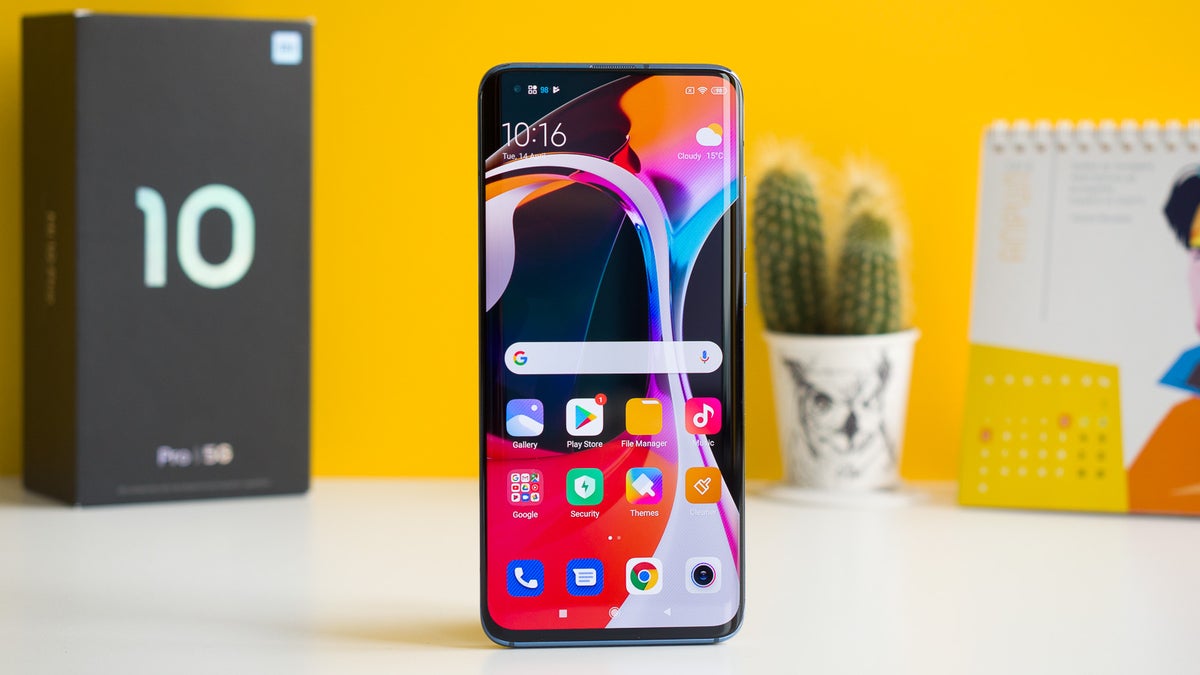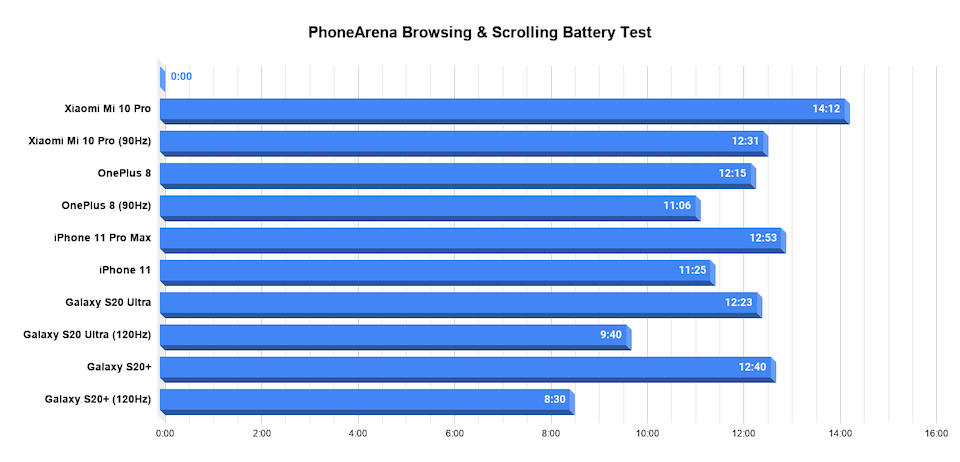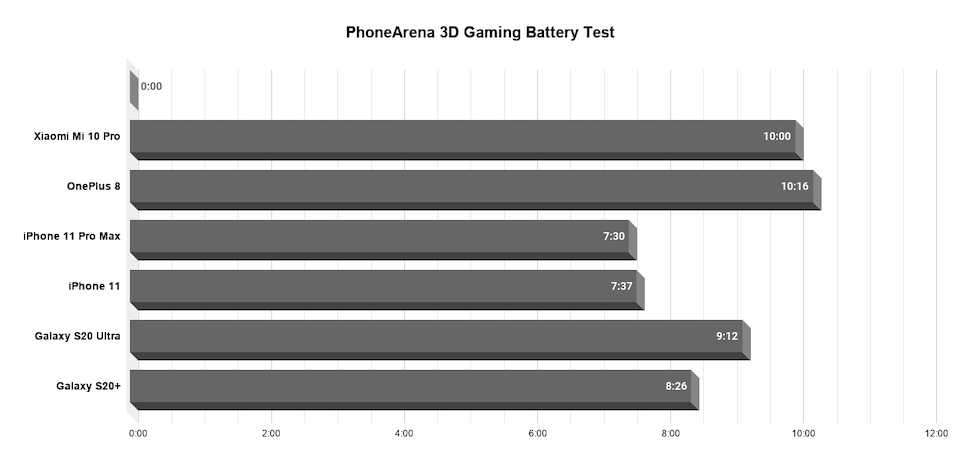Xiaomi Mi 10 Pro battery test complete: 90Hz vs 60Hz comparison

Having a massive, 4500mAh battery certainly pays off and if you are Xiaomi, a company known for aggressive power management, you know expectations are high for the new flagship on the block, the Xiaomi Mi 10 Pro.
And we are glad to say that after completing all of our battery tests, the Mi 10 Pro passes with flying colors and might just be the phone with the very best battery life of the year. Not only that, the Xiaomi Mi 10 Pro also has one of the fastest charging capabilities of any smartphone. This phone lasts long and it doesn't bind you to a cable for a long time, but how long exactly does it last?
Disclaimer: We use the same method for all the phones that we test. We set the brightness to the same level to equal the playing field using specialized equipment and we run the tests under the same conditions.
Browsing test: 90Hz vs 60Hz
We start exploring battery life with our browsing and scrolling test. We have run this same test twice: once with the default 60 Hertz refresh rate, and then, using the much smoother 90 Hertz refresh rate option. 90 Hertz is a game changer for the user experience, but it taxes the battery in a big way, especially if a phone maker fails to make the proper optimizations.
So how did the Xiaomi Mi 10 Pro do?
Saying it did well will be an understatement. Here are the scores...
Xiaomi Mi 10 Pro 60Hz vs 90Hz battery life comparison:
- 60Hz test result -- 14 hours and 12 minutes
- 90Hz test result -- 12 hours and 31 minutes
This is incredible. The Xiaomi Mi 10 Pro easily takes the first place in our battery rankings beating heavyweights like the iPhone 11 Pro Max (almost 4,000mAh battery) and the Samsung Galaxy S20 Ultra (5,000mAh battery cell).

What's interesting is that its 90 Hertz scores is roughly as good as those extremely long lasting phone. Excellent job, Xiaomi!
And comparing the 60Hz vs 90Hz scores, you notice that there is a difference of 1 hour and 41 minutes between the scores, which simply means you lose around 12% of battery life if you choose the 90Hz option. That is not a small number, but it's not huge either. In comparison, the 120Hz option on the S20 series results in around 25-30% decline in battery life compared to the 60Hz mode. While in the case with the Galaxy many people would have second thoughts about significantly crippling their battery life, here, picking the 90 Hertz option is a no brainer.
YouTube Video Streaming
Our next test measures something that most people do on a daily basis: YouTube video streaming.
The goal of this test is to give an accurate estimation of how long each phone will last for video streaming considering that there is a difference in the battery load compared to just scrolling the web. Playing videos is a more intense task and the phone also uses its loudspeaker, so the battery load is higher.

Good news is that the Xiaomi Mi 10 Pro does great on this test as well: it scores an amazing 11 hours and 30 minutes.
This beats the current record holder, the Samsung Galaxy S20 Ultra, by a full hour. Saying this phone lasts long is an understatement.
3D Gaming
Our final test is for the gamers out there. In this test, we compare the battery life on phones for 3D gaming, that is to say games that require a lot from the graphics chip on the phone and in exchange provide great visuals. Think games like Fortnite, PubG, Minecraft, Call of Duty and others from that caliber.
So how did the Xiaomi Mi 10 Pro did in this test? Take a look at its score and how it compares to other popular flagships below:

Interestingly, we see it scoring exactly 10 hours on the 3D gaming test run at 60 Hertz. This is just a few minutes less than the score we got on the OnePlus 8 which is based on the very same Snapdragon 865 chipset with the same powerful Adreno 650 graphics chip, and considering the same 1080p resolution on both phones it's only logical that the scores are similar.
It's also curious to see how the Xiaomi Mi 10 Pro is able to beat the Exynos-based Galaxy S20 Ultra by a significant margin, and it also seems to be more power-efficient in 3D gaming workloads when compared against the iPhone 11 family.
Fast Charging
The Mi 10 Pro supports record-breaking charging speeds of up to 50W
Hearing numbers like 50W fast charging sounds simply incredible for smartphones that just a few years back used to charge up at 5W speeds. And the Xiaomi Mi 10 Pro is one of a proud cohort of China-made smartphones that are pushing the boundaries.
The phone comes with a 65W charger that supports the Power Delivery standard, but the phone is limited at just slightly lower speeds of up to 50W. It's interesting that Xiaomi mentions that you can freely use this charger to also top up a compatible laptop or a tablet. A stand-alone charger with such a power often costs north of $50, so it's great that Xiaomi is bundling it in the box.
As always, the 50W fast charging speeds for the phone are available towards the beginning of the charging, while when you reach a good amount of charger, usually around the 70% level, speeds drop to much slower ones to protect the battery from wearing out quicker.
Xiaomi Mi 10 Pro Charging Speed:
- in 15 minutes - 44% charge
- in 30 minutes - 78%
- in 47 minutes - FULL 100% Charge
The Mi 10 Pro also supports extremely fast, 30W wireless charging. That's faster than the wired charge on many phones out there (the S20 series in-box chargers max out at 25W for example).
Follow us on Google News












Things that are NOT allowed:
To help keep our community safe and free from spam, we apply temporary limits to newly created accounts: